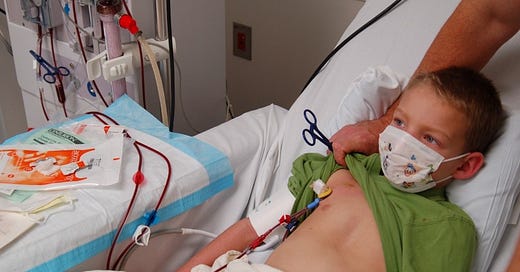Chronic kidney disease & transplantation in children - an update
April is National Donate Life Month
We celebrate National Donate Life Month in April each year, and Living Donor Day was the first Sunday in April, this year it fell on April 6th.
Recently, I posted an inspiring story about a baby girl born with severe kidney disease who was saved by her grandmother’s kidney donation!
This week I want to give you a short update about Chronic Kidney Disease in children. Everyone has heard of urinary tract infections in children, but most people are unaware of Chronic Kidney Disease (CKD).
Chronic kidney disease (CKD) in children occurs when there is irreversible and progressive kidney damage or reduction in kidney function for at least three months. The diagnosis is made with lab studies or abnormalities seen on a kidney biopsy. The rate of CKD progression depends on the underlying disorder.
Early stages of CKD in children can be asymptomatic. The prevalence of CKD varies with race or ethnicity. In North America, CKD is more prevalent among Black than white children. CKD occurs more often in males than females. Patients with CKD present for medical care throughout childhood: 15% of cases present below one year of age, 5% at 1-2 years, 16% at 2 to 6 years, 32% at 6 to 13 years, and 28% later from 13 to 18 years.
The main causes of CKD in children are congenital anomalies of the kidney and urinary tract. (CAKUT). These malformations account for 60% of CKD. Congenital disease includes obstructive uropathy, kidney hypoplasia, kidney dysplasia, and hereditary conditions. (Emily’s IPKD is a form of severe kidney dysplasia.) Glomerular diseases account for 10 to 20 % of CKD in children. Other disorders account for 20 to 30 % of CKD.
Children with glomerular disease tend to develop kidney failure later in childhood and before adulthood. CKD leads to progressive loss of kidney function. Management includes treatment of CKD complications and co-morbidities, like delayed growth and development, bone disease, and cardiovascular disease.
Hypertension and recurrent pyelonephritis (kidney infection) are important risk factors for CKD progression. Strict blood pressure control has been shown to demonstrate beneficial effect on slowing the progression of CKD in children. Neonatal factors - like prematurity and fetal growth restriction - exacerbate the progression of CKD.
Pediatric CKD is treated with several options called kidney replacement therapy (KRT) and these include peritoneal dialysis (PD), hemodialysis (HD), and kidney transplantation. CKD is staged according to glomerular filtration rate (GFR) and serum creatinine.
In well-resourced countries, KRT is typically begun in children with CKD stage 5, or end-stage kidney disease (ESRD). Globally, the reported incidence for ESKD ranges from 4 to 18 per million children worldwide. KRT is currently provided to 12 - 15.5 cases per million (cpm) U.S. children. In 2020, this represented 912 new patients with CKD receiving KRT from birth to 17 years old in the U.S. KRT occurs in 28 cpm European children and 9.5 cpm Australian children. Currently most children receiving KRT live in Europe, the U.S., Australia, New Zealand, and Japan.
Preemptive transplantation is now preferred to PD and HD for children with ESRD, because children who are transplanted have a lover mortality rate, better outcomes in quality-of-life measures, and better growth and development than either treatment with PD or HD.
Preemptive transplantation is more easily accomplished in children than in adults because of the availability of parental donors - in many cases who are a good tissue match, are young and healthy, and are willing to donate a kidney. Anything short of a perfect match will require immunosuppressive therapy for a lifetime.
When preemptive transplantation is not an option, then the child with kidney failure must be supported on PD or HD until transplantation can be accomplished. PD is preferred in infants and young children, because it is technically easier to perform. Home dialysis is always preferred over dialysis at a medical center, but the parents must do this procedure at home.
Children who are to receive HD need evaluation for vascular access. Vascular access includes either an arteriovenous (AV) fistula or a central venous tunneled catheter. AV fistulas require time to mature prior to use, sometimes weeks to months. Children who are to begin PD need to undergo abdominal surgery for placement of a PD catheter which can be used quickly.
Do you know how few pediatric nephrologists are practicing in the U.S. currently? There are only 1,120 board-certified pedi nephrologists and most are located at academic medical centers affiliated with children’s hospitals. I am lucky enough to have been married to one for over forty years, and I have loved hearing about all his “kidney kids.”
For more information please go to Healthy Children.org.
If you enjoy my writing and these stories, please hit the❤️ button below and restack by hitting the 🔄️ button. Then other people can find my work. Thanks for reading!





